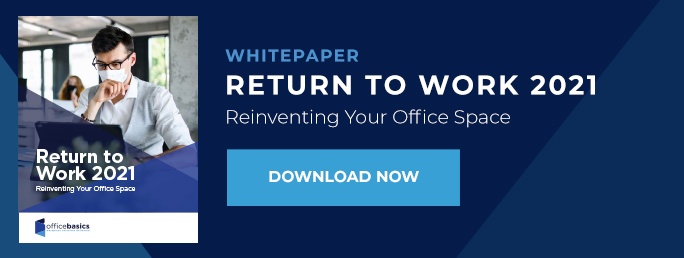The vast majority of workers look forward to going back to the office this year — at least part of the time — but many employees still have a lot of reservations.
According to a recent survey we conducted at Office Basics, 58% of respondents expressed only feeling moderate comfort returning to the office while another 7% feel “extremely concerned.”
Does your return-to-work plan have what it takes to help employees feel safe and comfortable in the office?
As office managers work to create an environment for employees that instills a sense of safety and comfort, consider incorporating the following action items:

Action Items for Wellness Plans
1. Health Checkpoints
Screening employees and visitors at the door for fever and other COVID-related symptoms is not a fool-proof solution to controlling the spread of illnesses at the office, but it can offer an extra layer of protection.
Here’s what you’ll need to incorporate health checkpoints into your return-to-work plan respectfully and successfully:
- Careful consideration for employees’ safety, privacy and concerns
- A designated checkpoint location
- One or more no-touch infrared thermometers
- A volunteer schedule to work the health checkpoint
- Protective clothing for those administering the health check
- A screening process that respects employee privacy
- Protocol for employees who do not pass the safety scan
2. Sanitizing Stations
According to the Centers for Disease Control and Prevention (CDC), washing your hands with plain soap and water is the best way to prevent the spread of diseases. When a sink and soap pump aren’t readily available, hand sanitizer that is at least 60% alcohol will do the trick.
Take sanitizing to the next level with strategically placed stations that include hands-free hand sanitizer dispensers, face masks, desk cleaning supplies, digital device cleaners, and other products that employees can easily access to keep their hands, personal space and belongings clean.
Ideal locations for sanitizing stations include:
- Restrooms
- Entrances and exits
- Elevators and touch screens
- Cafeterias and breakrooms
- Boardrooms
- Transactional counters (e.g. reception)
Action Items for Office Designs
3. Go Touchless
Hands-free appliances are a great way to make certain tasks more convenient, but they also improve sanitation by reducing the number of touchpoints around the office.
Since COVID-19 hit the scene, many individuals have become hyper-aware of the germs lingering on doorknobs, faucets, handles, buttons, and other communal high-touch surfaces.
Removing touchpoints around the office by replacing “manual appliances” with new, automated units sends a strong message to employees that your organization is on the cutting edge of cleanliness and safety.
Some of the most popular (and affordable) hands-free or “touchless” appliances include:
- Soap dispensers
- Towel dispensers
- Faucets
- Water coolers
- Coffee makers
- Trash cans
4. Flexible Floorplans
Some social scientists have predicted that months of social distancing could ultimately change human behavior. It may not be as easy as we think to return to confined public spaces or high-volume occupancy.
For this reason, office managers should start thinking about how to adapt floor layouts as a part of their return-to-work plan.
Rather than simply having an open space concept, which has received mixed reviews from employees over the years, focus on incorporating flexible design elements that give employees some control in creating a workspace that fits their level of comfort.
Modular couches, desk systems, and walls or partitions are the key to flexible floorplanning and make scaling workspaces for fluctuations in occupancy volume easier for office managers.
5. Outdoor Workspaces
Everyone could use a breath of fresh air, especially after hours of donning a mask indoors. A new office design trend picking up traction is the development of outdoor workspaces.
In addition to expanding workable space at the office to reduce occupancy volume, a recent study indicated that nature could improve mental health during the pandemic.
According to one researcher, nature acts as a buffer that reduces the effects of stress in the moment. In other words, creating outdoor gathering and working spaces for employees can markedly impact office well-being, not to mention attracting new talent.
Action Items for Office Management
6. Attendance Flexibility
In-person collaboration is important for innovation. However, this doesn’t mean office managers should discount the value of offering attendance flexibility.
The demand for remote work opportunities is higher than ever, which means that your return-to-work plan must take flex scheduling into consideration. Failure to do so could damage recruiting, retention, attrition and overall employee satisfaction.
7. More Encouragement
Fear is contagious, but so is positivity. One of the most powerful things office managers can do to help employees feel safe and comfortable at work is to be a source of optimism and encouragement.
Rather than dwell on the negative impacts of COVID-19, generate excitement around the “new normal” and all the possibilities that lie ahead.
Here are some ideas to help get the good vibes going:
- Create a compelling brand story video to revitalize the company’s mission statement and use it as a rallying cry that inspires employees to reassemble behind a shared purpose.
- Put more emphasis on career path planning and future opportunities for growth within the company.
- Create time and space for employees to express themselves, good or bad, and take the opportunity to respond in a way that either shifts or uplifts their perspective.
- Celebrate more. From themed days, birthdays and holidays to small personal or professional victories, celebrating as a company can unify the culture and give employees something to look forward to.
Final Action Item for Your Return-to-Work Plan:
Focus On Short-Term. Plan For Long-Term.
The pandemic will end, but many of the changes it catalyzed will remain permanent fixtures of the future.
The new normal is still in its infancy and liable to shift as new trends take shape. Rather than succumb to the overwhelm of so much change, office managers should focus on short-term strategies.
The key is to incorporate solutions that serve immediate needs but offer long-term ROI, such as quality office design features and enhancements to wellness plans.
If creating a return-to-work plan still feels like a daunting task, our Return-to-Work 2021 Guide has everything you need, including the latest survey results that reveal exclusive new insights to help you reinvent your office space.




